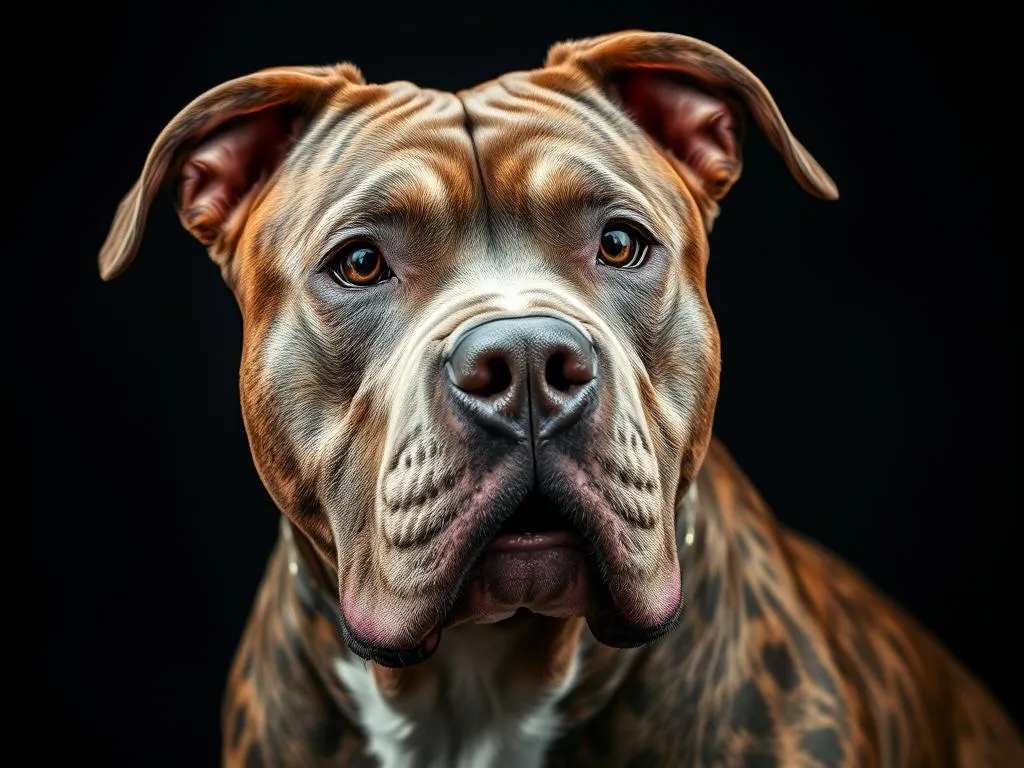
Introduction
Understanding different dog breeds is essential for both potential dog owners and canine enthusiasts alike. With an array of breeds varying in size, temperament, and appearance, there’s much to explore. Among these, the brindle pitbull stands out not only for its striking coat pattern but also for its unique combination of physical and personality traits.
The term “brindle” refers to a specific coat pattern characterized by a mix of dark and light stripes, giving the dog a distinctive appearance. This pattern is not just visually appealing; it also reflects a rich genetic background. The brindle pitbull is a popular choice for dog lovers due to its loyal nature, playful spirit, and striking looks.
Understanding the Pitbull Breed
History of the Pitbull
The origins of the pitbull trace back to the early 19th century when they were bred in England for bull-baiting and later for farm work. The breed’s ancestors were a mix of Bulldogs and Terriers, specifically bred for their strength, agility, and tenacity. Over time, as bull-baiting was outlawed, they transitioned into companion animals and versatile working dogs. The evolution of the breed has led to the multiple types of pitbulls we recognize today.
Characteristics of Pitbulls
The brindle pitbull typically showcases a strong, muscular build, standing between 18 to 21 inches tall and weighing anywhere from 30 to 85 pounds, depending on the specific type. Their short, smooth coat is easy to maintain, and the brindle pattern adds a unique flair to their appearance.
In terms of temperament, pitbulls are known for their affectionate nature. They are often described as loyal, courageous, and intelligent. These dogs thrive on human interaction and are known to be good with children, making them excellent family pets.
Common Misconceptions About Pitbulls
Despite their many positive traits, pitbulls often face negative stereotypes, primarily due to their history and media portrayal. Many people believe pitbulls are inherently aggressive, which is a misconception. The behavior of any dog largely depends on its upbringing, training, and socialization. Responsible ownership and early training can help mitigate any potential behavioral issues, allowing the brindle pitbull to flourish as a loving companion.
The Brindle Coat Pattern
What is Brindle?
Brindle is a coat pattern characterized by a mix of darker stripes over a lighter base color. The pattern can vary significantly, leading to unique appearances in each individual dog. The genetic factors influencing brindle patterns are complex, involving multiple genes that dictate the distribution and intensity of the stripes.
In brindle pitbulls, this distinct coat pattern enhances their overall charm, making them stand out in a crowd.
Other Breeds with Brindle Coats
While the brindle pitbull is a notable example, several other dog breeds can also exhibit brindle patterns. Breeds such as Boxers, Greyhounds, and even certain types of Mastiffs may display this unique coloration. However, the brindle pattern in pitbulls often appears more pronounced due to their muscular frame and shorter coat. This comparison highlights the brindle pitbull as a breed that not only embodies strength but also boasts an eye-catching aesthetic.
Caring for a Brindle Pitbull
Nutrition and Diet
Proper nutrition is crucial for the health and well-being of your brindle pitbull. A balanced diet that includes high-quality dog food rich in protein is essential for maintaining their muscle mass and energy levels. Look for foods that list meat as the first ingredient and avoid those high in fillers like corn and soy.
Common dietary restrictions and allergies that may affect pitbulls include sensitivities to grains and certain proteins. It’s essential to monitor their response to new foods and consult with a veterinarian if any allergic reactions occur.
Exercise Requirements
Pitbulls, including the brindle pitbull, have high energy levels and require regular physical activity. Daily walks, playtime, and engaging in dog sports can help keep them physically fit and mentally stimulated. Aim for at least an hour of exercise each day, which can include activities like fetch, agility training, or even swimming.
Grooming and Maintenance
Grooming a brindle pitbull is relatively straightforward due to their short coat. Regular brushing will help reduce shedding and keep their coat healthy. Bathing should be done as needed, usually no more than once a month, to avoid stripping their coat of natural oils. Pay special attention to their ears and paws, as these areas can require additional care.
Training a Brindle Pitbull
Basic Training Techniques
Early training and socialization are vital for ensuring a well-rounded brindle pitbull. Start with basic commands like sit, stay, and come, using positive reinforcement techniques such as treats and praise to encourage good behavior. Socializing your pitbull with other dogs and people will help them develop confidence and reduce any potential anxieties.
Addressing Behavioral Issues
Common behavioral problems in pitbulls can include jumping, excessive barking, and chewing. Addressing these issues early is crucial. Consistency in training, along with patience, will help correct unwanted behaviors. Implementing structured routines and providing mental stimulation through training can also be beneficial.
Engaging Activities for Mental Stimulation
Mental stimulation is as important as physical exercise for brindle pitbulls. Engage them with puzzle toys, interactive games, or obedience training sessions that challenge their intellect. Activities like scent work or teaching new tricks can keep their minds sharp and prevent boredom.
Health Considerations for Brindle Pitbulls
Common Health Issues
Like all breeds, brindle pitbulls can be prone to certain health issues. Common concerns include hip dysplasia, skin allergies, and heart disease. Regular veterinary check-ups are essential for early detection and management of any potential health problems. Keeping an eye on their weight and ensuring they maintain a healthy lifestyle can also help mitigate these risks.
Preventative Care
Preventative care is crucial for the health of your brindle pitbull. Ensure they are up to date on vaccinations and flea/tick preventatives. Spaying or neutering your pet not only prevents unwanted litters but can also help reduce certain health risks and behavioral issues.
Finding a Brindle Pitbull
Adoption vs. Breeding
When considering a brindle pitbull, you may face the decision between adopting and purchasing from a breeder. Adoption from shelters can provide a loving home to a dog in need, while reputable breeders can offer specific lineage and health guarantees. Each option has its pros and cons, and it’s essential to weigh these carefully.
Where to Find a Brindle Pitbull
If you choose to adopt, local shelters or rescue organizations are excellent places to start. Many pitbulls, including brindle varieties, are often waiting for loving homes. If you decide to go through a breeder, ensure they are reputable and prioritize the health and well-being of their dogs. Look for breeders who provide health clearances and are willing to answer your questions about the breed.
Conclusion
The brindle pitbull is a remarkable breed that combines beauty with strength and loyalty. Understanding this unique dog and its needs is vital for responsible pet ownership. With the right care, training, and socialization, a brindle pitbull can bring joy and companionship to any home. Whether you choose to adopt or responsibly breed, the experience of sharing your life with a brindle pitbull can be immensely rewarding.









